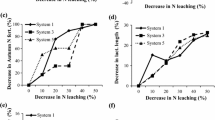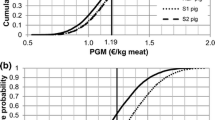Abstract
Abatement of emissions following the application of manures to land has been identified as a priority to reduce emissions of ammonia (NH3). However, the conventional method of spreading slurry, surface broadcasting by splash plate applicator, is rapid and inexpensive while application techniques which reduce emissions of NH3 impose an additional cost on the farmer. We critically reviewed the methodology used to estimate the additional costs of spreading livestock manures to land by the use of reduced NH3 emission (RAE) techniques. The input values used to calculate costs were as follows: purchase price of tractors and RAE spreading machines; depreciation, of both the tractor and the spreader; interest rates, on loan or expended capital; fuel consumption; repairs; labour costs. This approach is consistent with the method to estimate the cost of abatement techniques given in the BREF guidance document. As a result of revising the calculations with updated input costs the additional cost of spreading using reduced-emission spreading equipment was from £0.52 to £0.65 per m3 slurry applied by RAE techniques. The costs of spreading manure arise mainly from labour (27 %), Fuel (23 %), spreader costs (10 % from repairs and maintenance and 12 % from depreciation) and tractor costs (11 % from repairs and maintenance and 10 % from depreciation). Since most of the labour and fuel costs incurred during the spreading of slurry arise from travelling from the slurry store to the field, the reduced work rates of RAE machines, and greater fuel requirements for pulling injectors, incur only moderate additional costs. These cost estimates were within the range of additional costs reported by commercial farmers who had adopted RAE techniques in a pilot study. Estimates of the additional costs of applying livestock manures by RAE techniques will inevitably vary due to differences among farms and contracting operations with respect to the volumes of manure to be spread, differences in fuel and labour costs and in depreciation and interest rates. Nevertheless, we conclude that the estimates of £0.65 m−3 for slurry and £0.54 t−1 for manures spread using farm equipment are broadly reliable. We also conclude that the costs of RAE techniques for manures applied by contractor will be substantially less than for manures applied by farm machinery.
Access this chapter
Tax calculation will be finalised at checkout
Purchases are for personal use only
Similar content being viewed by others
References
Amann M, Bertok I, Cofala J, Heyes C, Klimont Z, Rafaj P, Schöpp W, Wagner F (2008) National emission ceilings for 2020 based on the 2008 climate & energy package. NEC scenario analysis report nr. 6. International Institute for Applied Systems Analysis (IIASA), Laxenburg, Austria
Anon. (2002) Defra project WA0710, evaluation of ammonia mitigation options. http://randd.defra.gov.uk/Document.aspx?Document=WA0710_558_FRP.doc. Accessed 14 Aug 2014
Anon. (2003) Integrated Pollution Prevention and Control (IPPC) reference document on best available techniques for intensive rearing of poultry and pigs, July 2003. http://eippcb.jrc.es. Accessed 17 Oct 2014
Bittman S, Kowalenko CG, Hunt DE, Schmidt O (1999) Surface-banded and broadcast dairy manure effects on tall fescue yield and nitrogen uptake. Agron J 91(5):826–833. doi:10.2134/agronj1999.915826x
Döhler H, Eurich-Menden B (2004) Costs of ammonia abatement techniques in Germany on two model farms. UNECE Ammonia Expert Group, Poznan
Frost P, Mulholland M (2004) Alternative slurry spreading systems. Department of Agriculture and Rural Development (Northern Ireland). Technical note
Laws A, Pain BF, Webb J, Forrester A (2003) Added benefits in adopting techniques to abate ammonia emissions on UK farms. In: British Grassland Society 7th research conference, University of Wales, Aberystwyth, UK
Pineiro C, Pérez AI, Illescas P, Montalvo G, Herrero M, Giráldez R, José Sanz M, Bigeriego M (2006) Spanish Ministry of Agriculture, Fisheries and Food project for the IPPC Directive implementation in Spain. Results of 2004-2005 and future work. In: Petersen SO (ed) 12th Ramiran international conference technology for recycling of manure and organic residues in a whole-farm perspective, vol I, DIAS report Plant production no. 122, August 2006, pp 175–178
Webb J, Menzi H, Pain BF, Misselbrook TH, Dämmgen U, Hendriks H, Döhler H (2005) Managing ammonia emissions from livestock production in Europe. Environ Pollut 135:399–406
Webb J, Ryan M, Anthony SG, Brewer A, Laws J, Aller FA, Misselbrook TH (2006) Identifying the most cost-effective means of reducing ammonia emissions from UK agriculture using the NARSES model. Atmos Environ 40:7222–7233
Webb J, Morgan J, Pain B, Eurich-Menden B (2009) Review of the efficiency of methods to reduce emissions of ammonia following the application of manures to land, their costs, potential agronomic benefits and impacts on emissions of nitrous oxide. Report to the task force on reactive nitrogen. http://www.clrtap-tfrn.org/sites/clrtap-tfrn.org/files/documents/EPMAN%20Documents/SpreadRev_All_151009.pdf. Accessed 14 Aug 2014
Webb J, Pain B, Bittman S, Morgan J (2010) The impacts of manure application methods on emissions of ammonia, nitrous oxide and on crop response—a review. Agric Ecosyst Environ 137:39–46
Author information
Authors and Affiliations
Corresponding author
Editor information
Editors and Affiliations
Rights and permissions
Copyright information
© 2015 Springer Science+Business Media Dordrecht
About this chapter
Cite this chapter
Webb, J., Morgan, J., Pain, B. (2015). Cost of Ammonia Emission Abatement from Manure Spreading and Fertilizer Application. In: Reis, S., Howard, C., Sutton, M. (eds) Costs of Ammonia Abatement and the Climate Co-Benefits. Springer, Dordrecht. https://doi.org/10.1007/978-94-017-9722-1_6
Download citation
DOI: https://doi.org/10.1007/978-94-017-9722-1_6
Publisher Name: Springer, Dordrecht
Print ISBN: 978-94-017-9721-4
Online ISBN: 978-94-017-9722-1
eBook Packages: Earth and Environmental ScienceEarth and Environmental Science (R0)




